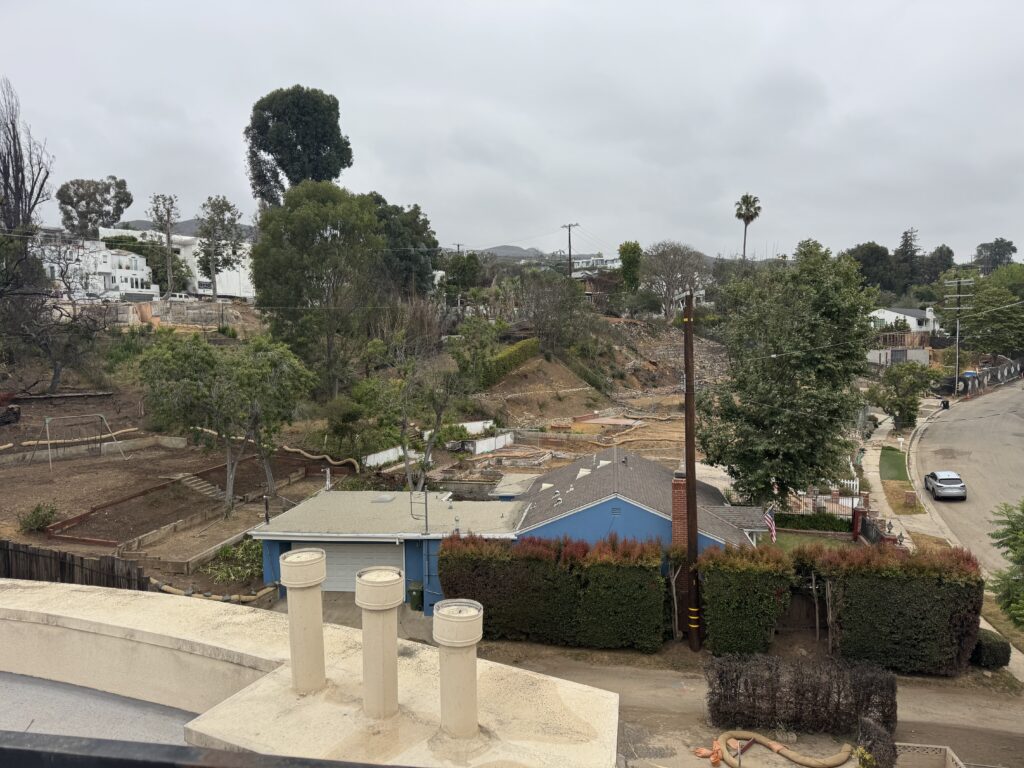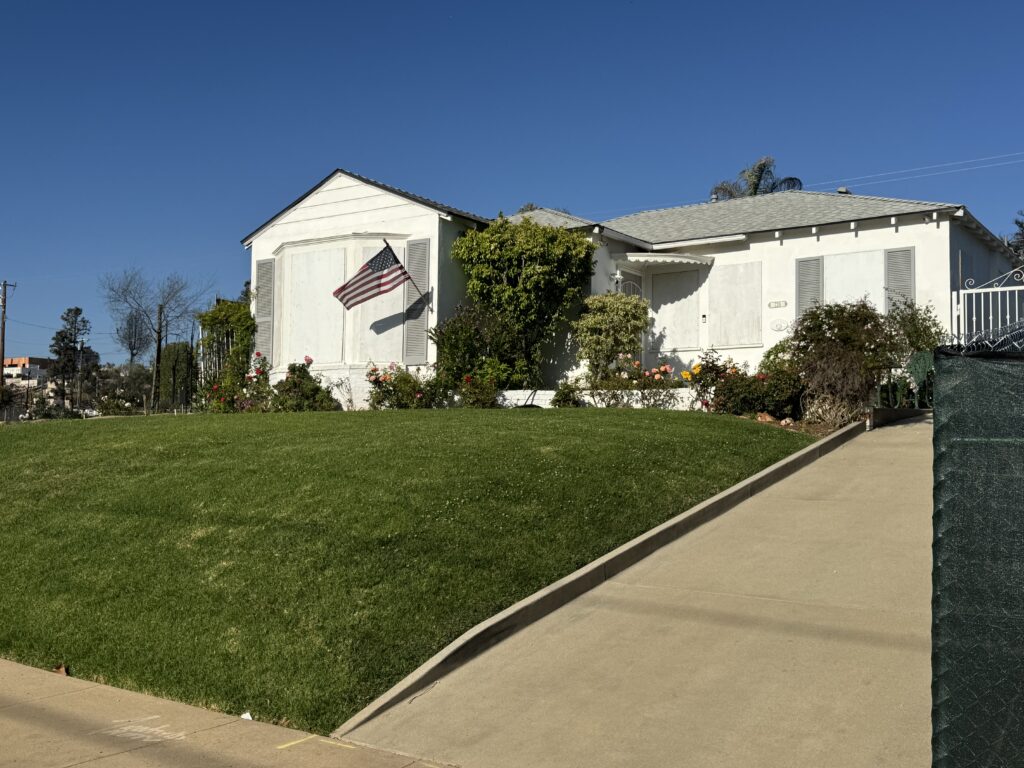(The following letter was sent to the Zone Zero Regulatory Advisory Committee, California Board of Forestry and Fire Protection, P.O. Box 944246, Sacramento, CA 94244-2460)

The blue home, surrounded by vegetation, large trees and green grass survived the fire. The house on one side and the apartment building on the other, did not..
My home and my neighbor’s home stand today in Pacific Palisades because of the large trees, hedges and well-maintained landscape surrounding our properties.
Large trees serve as ‘EMBER CATCHERS,’ an effective net that catches the flying sparks, directly protecting the structures adjacent. Removing vegetation near homes will leave us like sitting ducks when the next threat of fire approaches, with no defensive barrier to protect us. Fact-based science proves that Zone 0 is NOT a common-sense solution.
We urge the Committee to delay implementation of these rules until a thorough, field-based study is conducted of homes that survived the Palisades Fire—particularly those that were protected by well-hydrated hedges and maintained landscaping. We also request formal engagement with the PPRA (Pacific Palisades Resident Association), the Palisades Forestry Committee, and neighboring homeowners associations (HOAs) that share our concerns regarding these potential requirements.
Key Points:
Field Evidence from the Palisades Fire: Our residents possess video documentation and firsthand accounts demonstrating that, in several instances, hedges and closely-managed vegetation directly contributed to fire suppression and home survival during the Palisades Fire.
Residents who remained to defend their properties observed that these vegetative barriers, when properly hydrated and maintained, acted as a buffer against ember and radiant heat—directly contradicting the premise that all vegetation within five feet of a structure must be eliminated.
Need for Context-Specific, Evidence-Based Regulation: We share the concerns raised in the letter from MySafe:LA, which emphasizes that wildfire mitigation policy must be evidence-based and adaptable to regional and community-specific conditions.
The dense, urbanized character of Pacific Palisades—with homes built on small lots, in close proximity, and often with protective hedges and trees near structures—presents challenges and solutions that are not reflected in laboratory or warehouse testing environments, such as those conducted by the Insurance Institute for Business & Home Safety (IBHS). Regulation based solely on such controlled settings risks imposing impractical and ineffective mandates on Southern California communities.
Risk to Community Resilience and Insurability: We are deeply concerned thati nflexible Zone 0 mandates could destabilize our community’s fire resilience, discourage incremental risk reduction, and expose homeowners to insurance cancellations or denials—even when homes are demonstrably safer due to on-the-ground conditions and mitigation efforts. A one-size-fits-all approach could undermine, rather than strengthen, our collective ability to maintain insurable and fire-resilient neighborhoods.
Request for Engagement and Study: Prior to any final adoption of Zone 0 rules, we request that the Committee:
- Commit to a near-term study of the role of vegetation—especially hedges and trees—in home survivability during the Palisades Fire, with direct input from affected residents and local fire experts.
- Formally engagewith the PPRA, Palisades Forestry Committee, and adjacent HOAs in the regulatory process, ensuring that our practical experience and that evidence inform any new requirements.
- Adopt a tiered, context-sensitive implementationsimilar to that proposed by MySafe:LA, recognizing the unique challenges of older, densely built communities and balancing regulatory clarity with achievable, science-based outcomes.
- Support pilot projects and demonstration siteswithin Pacific Palisades to evaluate the effectiveness of diverse mitigation strategies under real-world conditions.
Our Vision for Balanced, Effective Policy
We support the goal of a fire-resilient and insurable community. However, we believe this is best achieved through regulations that reflect the realities of Southern California’s urbanized wildland-urban interface (WUI)—not through mandates developed in isolation from field conditions.
We urge the Committee to consider the lessons from the Palisades Fire, the concerns of organized community groups, and the need for flexibility and adaptability in
regulatory language. The PPRA stands ready to collaborate on research, education, and implementation strategies that genuinely reduce wildfire risk without sacrificing community character or livability. We appreciate your consideration of our position and look forward to your response and continued dialogue.
Tracey and David Price


It’s one assault after another. They just won’t stop.
Fill the reservoirs and check the fire hydrants
That will go a lot farther in “fire safety” then “zone zero”
No on Zone Zero”
P.S. the 6 condos up on Michael lane in the highlands essentially had
“Zone zero” and they still burned. Go look
Thank you for this well-reasoned and articulate guidance.
I could not agree more !!!
I could not agree more!! Instead of the constant assault on homeowners.. how about making sure there’s water in the reservoirs and enough Firefighters!! I understand clearing dead leaves, and making sure our plants are hydrated, but stripping our properties of our beautiful landscaping is not the answer!!!
I could not agree more!! Instead of another assault on homeowners.. how about making sure there’s water in the reservoirs and enough Firefighters!! I understand clearing dead leaves, and making sure our plants are hydrated, but stripping our properties of our beautiful landscaping is not the answer!!!